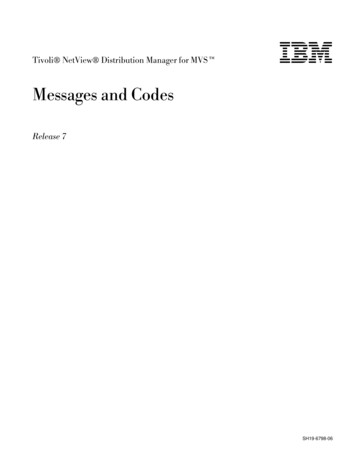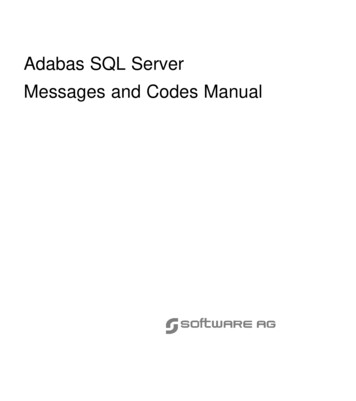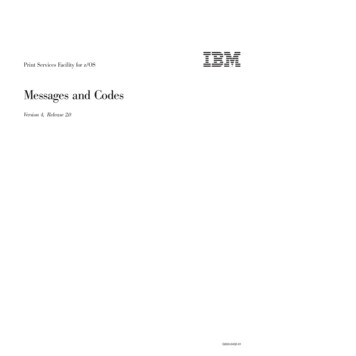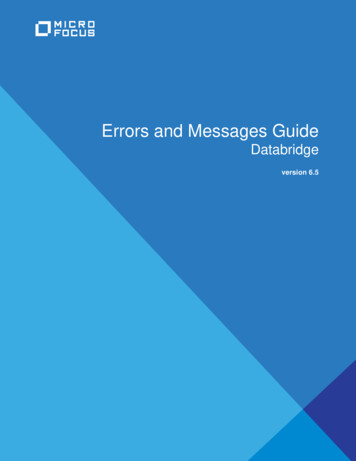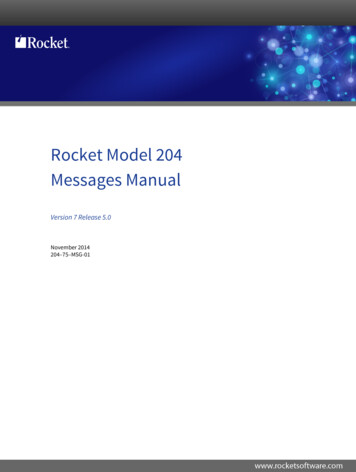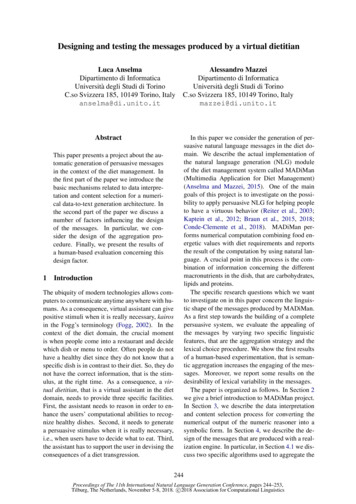
Transcription
Designing and testing the messages produced by a virtual dietitianLuca AnselmaDipartimento di InformaticaUniversità degli Studi di TorinoC.so Svizzera 185, 10149 Torino, Italyanselma@di.unito.itAlessandro MazzeiDipartimento di InformaticaUniversità degli Studi di TorinoC.so Svizzera 185, 10149 Torino, Italymazzei@di.unito.itAbstractIn this paper we consider the generation of persuasive natural language messages in the diet domain. We describe the actual implementation ofthe natural language generation (NLG) moduleof the diet management system called MADiMan(Multimedia Application for Diet Management)(Anselma and Mazzei, 2015). One of the maingoals of this project is to investigate on the possibility to apply persuasive NLG for helping peopleto have a virtuous behavior (Reiter et al., 2003;Kaptein et al., 2012; Braun et al., 2015, 2018;Conde-Clemente et al., 2018). MADiMan performs numerical computation combining food energetic values with diet requirements and reportsthe result of the computation by using natural language. A crucial point in this process is the combination of information concerning the differentmacronutrients in the dish, that are carbohydrates,lipids and proteins.The specific research questions which we wantto investigate on in this paper concern the linguistic shape of the messages produced by MADiMan.As a first step towards the building of a completepersuasive system, we evaluate the appealing ofthe messages by varying two specific linguisticfeatures, that are the aggregation strategy and thelexical choice procedure. We show the first resultsof a human-based experimentation, that is semantic aggregation increases the engaging of the messages. Moreover, we report some results on thedesirability of lexical variability in the messages.The paper is organized as follows. In Section 2we give a brief introduction to MADiMan project.In Section 3, we describe the data interpretationand content selection process for converting thenumerical output of the numeric reasoner into asymbolic form. In Section 4, we describe the design of the messages that are produced with a realization engine. In particular, in Section 4.1 we discuss two specific algorithms used to aggregate theThis paper presents a project about the automatic generation of persuasive messagesin the context of the diet management. Inthe first part of the paper we introduce thebasic mechanisms related to data interpretation and content selection for a numerical data-to-text generation architecture. Inthe second part of the paper we discuss anumber of factors influencing the designof the messages. In particular, we consider the design of the aggregation procedure. Finally, we present the results ofa human-based evaluation concerning thisdesign factor.1IntroductionThe ubiquity of modern technologies allows computers to communicate anytime anywhere with humans. As a consequence, virtual assistant can givepositive stimuli when it is really necessary, kairosin the Fogg’s terminology (Fogg, 2002). In thecontext of the diet domain, the crucial momentis when people come into a restaurant and decidewhich dish or menu to order. Often people do nothave a healthy diet since they do not know that aspecific dish is in contrast to their diet. So, they donot have the correct information, that is the stimulus, at the right time. As a consequence, a virtual dietitian, that is a virtual assistant in the dietdomain, needs to provide three specific facilities.First, the assistant needs to reason in order to enhance the users’ computational abilities to recognize healthy dishes. Second, it needs to generatea persuasive stimulus when it is really necessary,i.e., when users have to decide what to eat. Third,the assistant has to support the user in devising theconsequences of a diet transgression.244Proceedings of The 11th International Natural Language Generation Conference, pages 244–253,Tilburg, The Netherlands, November 5-8, 2018. c 2018 Association for Computational Linguistics
3. NLU/IEservice4. ReasonerserviceRecipeQRCode1. app2. DietManagerserviceDB Users5. NLGserviceDBRecipesFigure 1: A schema of the MADiMan architecture.messages. In Section 5, we discuss the experimental setting that we use to give a first human-basedevaluation of the message generator. Finally, Section 6 closes the paper with some discussions andpointing on future work.2The MADiMan ArchitectureThe MADiMan system is a virtual dietitian designed: (1) to recover the nutritional informationdirectly from a specific recipe, (2) to reason overrecipes and diets by allowing some forms of dietdisobedience, and (3) to persuade the user to minimize these acts of disobedience. MADiMan offersfacilities to check the compatibility and to foreseethe impact that a specific meal has with a specificdiet.In Figure 1 we depict the architecture of thesystem implementing the MADiMan virtual dietitian. The information flow is: (1) A user, by using an app, recovers the specific recipe of a dishwhich she wants to eat. (2) The app, communicating with the DietManager service, retrieves theuser diet together with the list of the food that theuser has eaten in the last days. (3) The NLU/IEmodule computes the salient nutrition informationabout the specific course. (4) The Reasoner, using the user diet and the list of the food that hasbeen eaten in the last days, produces the final recommendation about the dish for the user. (5) TheNLGenerator uses the recommendation given bythe Reasoner, produces an explanation for the userin simple natural language. (6) The DietManagersends the result produced by the NLGenerator tothe app: the user will see this final result on hersmartphone. If the user decides to eat the dish, theapp will send this information to the DietManagerthat will update the list of food eaten.The reasoning module is a numeric reasonerbased on Simple Temporal Problems (STPs)(Dechter et al., 1991). In a diet it is necessaryto consider parameters such as energy require-ments and amount of macronutrients. The medical literature (e.g., (LARN, 2014)) provides Dietary Reference Values (DRVs) that can be computed from user information such as weight, gender, age, lifestyle. For example, let us considera 40-year-old male who is 1.80 m tall, weighs71.3 kg and has a sedentary lifestyle; such a person has an energy requirement of 2450 kcal/day.Moreover, he is recommended to assume (LARN,2014), e.g., 260 kcal/day of proteins, 735 kcal/dayof lipids and 1455 kcal/day of carbohydrates. InMADiMan we represent the DRVs as STP constraints (Anselma et al., 2017). STP models a setof constraints as a conjunction of bounds on differences. c x y d, i.e., the distance between the time points x and y is within c and d. Inour setting, by substituting the temporal distancebetween temporal points of STP with the DRVsand the caloric values of a dish distributed on thethree macronutrients. Thus, e.g., a constraint 500kcal lunchE lunchS 600 kcal imposesthat the distance between the start and the end oflunch is between 500 and 600 kcal, i.e., that lunchprovides 500-600 kcal. Thus, By using the idealvalue for calories (see Fig. 2), MADiMan evaluates the compatibility of the specific dish withthe actual status the diet. Moreover, in order toprovide a user-friendly information not limited to“consistent/inconsistent” answer and to make italso useful for the sake of user persuasion, MADiMan converts the numeric reasoning into a symbolic form that is suitable for the generation of NLmessages (Reiter, 2007).In the next sections, we describe the detail of thealgorithm designed to convert the numerical computation in symbols and to elaborate these symbolsin order to produce messages.3Data interpretation: convertingnumbers into categoriesIn order to show to the user a meaningful feedback, it is necessary to interpret the data resultingfrom the STP. We consider the case where the userproposes to the system a dish, the system obtainsits caloric value, translates it along with the user’sdiet and past meals into an STP and, by propagating the constraints, obtains the minimal network.For sake of clarity, we present the content selection algorithm by considering one single genericmacronutrient, but the real suitability of a dish depends on the results of the three macronutrients245
(see Section 4).I1 Using the resulting STP it is possible to classify the proposed dish in one of the following fivecases: permanently inconsistent (I1 ), occasionally inconsistent (I2 ), consistent and not balanced(C1 ), consistent and well-balanced (C2 ) and consistent and perfectly balanced (C3 ). In the casesI1 and I2 the energy supply of the dish is inconsistent. In case I1 the energy supply is inconsistent with regard to the user’s diet as representedin the STP considering the tolerance values. Thedish cannot be accepted even independently of theother food the user may possibly eat. This caseis detected by considering whether the nutritionalvalue of the dish violates a constraint in the STP.In case I2 the dish per se does not violate thediet constraints, but – considering the past mealsthe user has eaten – it would preclude him to beconsistent with the diet. Thus, it is inconsistentnow, but in the future, e.g., next week, it could become possible to choose it. This case is detectedby determining whether the energy supply, despiteit satisfies the constraints in the initial STP, is inconsistent with the STP that contains also the constraints related to the food that the user has actually eaten so far.maxI2 C 1 not balancedC 2 w ininconsistentC 2 - w ellbalancedC 1 - not balancedI2 I1 -inconsistentFigure 2:Classification of an inconsistent/consistent value of a meal’s energy supplygiven the minimum and maximum value of anSTP constraint.of energy supply for a meal. If a meal is in excesswith regard to the ideal value, we add a symbolto the category (e.g. C2 ) to denote the deviation.In contrast, if a meal is lacking, we add a symbol to the category (e.g. C1 ). This information isexploited in the generation of the messages.In the cases C1 , C2 and C3 the value of the energy supply is consistent with the diet, also takinginto account the other meals that the user has already eaten. It is possible to detect that a meal isconsistent by exploiting the minimal network ofthe STP: if the value of the energy supply is included between the lower and upper bounds of therelative STP constraint, then the STP is certainlyconsistent and the meal is consistent with the diet.A consistent but not balanced choice of a meal willhave consequences on the rest of the user’s diet because the user will have to “compensate” it. Thus,we distinguish three cases depending on the levelof the adequacy to the diet of the meal’s energysupply. In order to discriminate between the casesC1 , C2 and C3 , we consider how the value of theenergy supply stacks upon the allowed range represented in the related STP constraint. We assumethat the mean value is the “ideal” value accordingto the diet’s goals and we consider two parametricuser-adjustable thresholds relative to the mean: weclassify the meal according to the distance fromthe ideal value as not balanced (C1 ), well balanced(C2 ) or perfectly balanced (C3 ) (see Fig. 2). Inparticular, we distinguish between excess or lack4Document/Sentence planning andrealizationAs a working hypothesis, in this stage of theproject, MADiMan produces messages followinga fixed rhetorical structure and the document planfollows a very simple fixed schema. The final message will be composed by two parts: an overallevaluation of the dish and three evaluations forthe macronutrients (i.e., carbohydrates, lipids, proteins)1 . For the sake of clarity, we now describethe message by assuming one single macronutrient and in Section 4.1 we discuss how to aggregatethe three messages generated for the three different macronutrients.The sentence generated for expressing the overall evaluation is a single declarative sentence. Inorder to give a little bit of variation flavor in thesyntactic shapes of the messages, we decided to1We plan to add a suggestion on the future dishes to eat tothe final message in next work.246
use a negative copula for I1 , a declarative for I2 ,and a positive copula for C1 or C2 and C3 . Inparticular, the overall evaluation is non buono (notgood) or non va bene (not OK) when there is atleast one macronutrient classified as I1 or I2 , respectively. In alternative, the global evaluation isbuono (good) or molto buono (very good) whenthere is at least one macronutrient classified as C1or C2 respectively. Finally, the global evaluationis a ottima scelta (great choice) (see Table 1).perts, (4) Consistency: people do as they said theywould, (5) Consensus: people do as other peopledo, (6) Liking: we say yes to people we like. Notethat compared to the six Cialdini’s persuasion patterns, all the messages in Table 1 belong to thepatterns of authority and consistency. With respectto the low-level linguistic strategies, by following(de Rosis and Grasso, 2000), we used a numberof adverbs, e.g. davvero, molto, leggermente (really, very, lightly) in order to enhance or mitigatea message. Furthermore, compared to Guerini etal. persuasive strategies taxonomy (Guerini et al.,2007), we can see that all the messages belong toone single category, called action-inducement &goal-balance & positive-consequence. This strategy induces an action (i.e. to choose a dish), byusing the user’s goal (i.e. a healthy diet) and byusing the benefits deriving from this goal.The sentences have been eventually realized byusing the SimpleNLG-IT engine realizer, a portingof SimpleNLG for Italian language (Gatt and Reiter, 2009; Mazzei et al., 2016). So, the messagespreviously described have been primary encodedin the form of quasi-trees and secondary, afteraggregation (Section 4.1) and word-lexicalization(Section 4.2), realized by using SimpleNLG
Dipartimento di Informatica Universita degli Studi di Torino C.so Svizzera 185, 10149 Torino, Italy mazzei@di.unito.it Abstract This paper presents a project about the au-tomatic generation of persuasive messages in the context of the diet management. In the first part of the paper we introduce the basic mechanisms related to data interpre-tation and content selection for a numeri-cal data .


